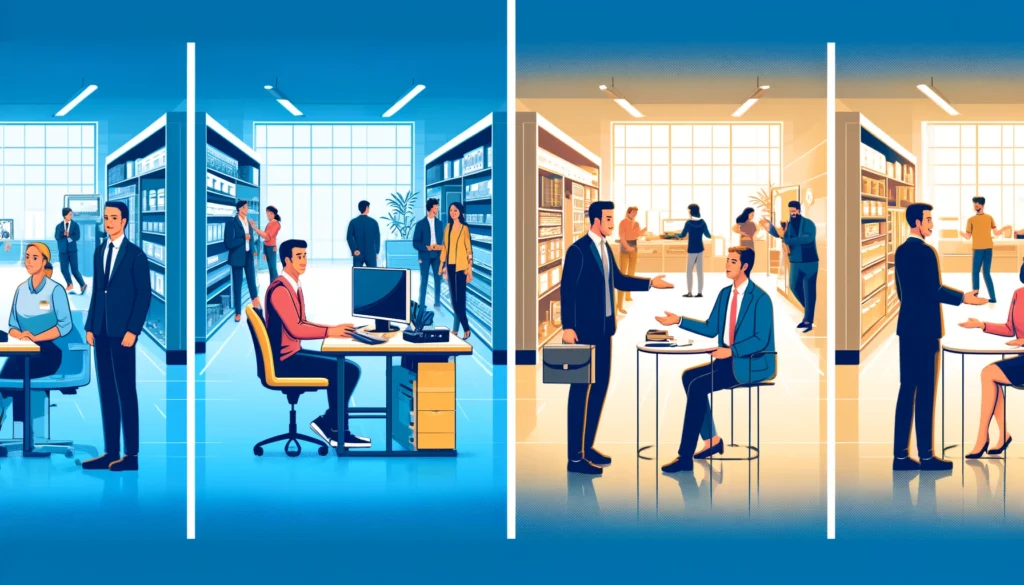Are Organizations Providing Employee Experience Similar to Customer Experience? Understanding the Differences and Necessities

In today’s dynamic business environment, the terms “employee experience” (EX) and “customer experience” (CX) have gained significant prominence. While customer experience focuses on how clients perceive their interactions with a company, employee experience pertains to the perceptions and feelings employees have about their workplace. Both concepts are crucial to the success and sustainability of modern organizations, as they directly impact customer satisfaction, employee retention, and overall organizational performance.
Several organizations have recognized the parallels between EX and CX and have made concerted efforts to align the two. The rationale behind this alignment is straightforward: happy employees are more likely to provide excellent service, leading to satisfied customers. However, despite the apparent similarities, the approaches to enhancing EX and CX can differ considerably, and the outcomes may not always align perfectly.
The purpose of this blog post is to delve into the intricacies of employee experience and customer experience, examining why the two are not always synonymous. We will explore the fundamental differences between internal and external experiences and discuss the necessity of tailoring strategies to address the unique needs of employees and customers. By understanding these distinctions, organizations can better optimize both EX and CX, ultimately fostering a more harmonious and productive environment.
Defining Employee Experience and Customer Experience
Employee Experience (EX) and Customer Experience (CX) are fundamental concepts that drive organizational success. Though they share similarities, their distinct focus areas and goals necessitate different approaches.
Employee Experience (EX) refers to the holistic journey an employee undertakes within an organization, encompassing all interactions, touchpoints, and environments they encounter from recruitment through to their exit. Key elements of EX include onboarding, training, work environment, employee engagement, career development, and work-life balance. The primary stakeholders in EX are the employees themselves, HR professionals, managers, and leadership teams. The ultimate goals of EX are to enhance employee satisfaction, foster engagement, and improve retention rates. A positive employee experience is instrumental in creating a committed workforce that is aligned with organizational goals and values.
Customer Experience (CX), on the other hand, pertains to the entirety of a customer’s interactions with a brand, product, or service throughout their journey. This journey includes awareness, consideration, purchase, usage, and post-purchase support. Key elements of CX involve customer service, product quality, user interface, marketing communications, and feedback mechanisms. The primary stakeholders in CX are the customers, customer service teams, marketing departments, product developers, and sales personnel. The ultimate goals of CX are to achieve high levels of customer satisfaction, build loyalty, and drive repeat business. A superior customer experience can significantly impact a company’s reputation and bottom line by fostering strong customer relationships and advocacy.
In summary, while both EX and CX focus on creating positive and engaging experiences, they cater to different audiences and encompass different touchpoints and interactions. Understanding these nuances is crucial for organizations aiming to excel in both domains and achieve overall success.
Similarities Between Employee and Customer Experience
In the modern business landscape, the concepts of Employee Experience (EX) and Customer Experience (CX) are increasingly intertwined. Both experiences are designed to create positive, engaging, and memorable interactions, and they share several strategic approaches aimed at achieving these goals.
One of the most prominent similarities between EX and CX is the emphasis on personalized communication. Just as customers appreciate personalized messages and tailored offers, employees value individualized attention and recognition. Personalization in communication fosters a sense of belonging and importance, whether the audience is employees or customers.
Feedback mechanisms also play a crucial role in both EX and CX. Organizations that excel in CX often employ methods such as customer surveys, focus groups, and real-time feedback tools to understand customer needs and sentiments. Similarly, for EX, companies utilize employee surveys, suggestion boxes, and performance reviews to gather insights and improve the workplace environment. This continuous loop of feedback and action ensures that both employees and customers feel heard and valued.
Technology serves as another common thread between EX and CX. Advanced technologies, such as Customer Relationship Management (CRM) systems, enhance CX by providing a seamless and personalized customer journey. On the EX front, Human Resource Management Systems (HRMS) and collaboration tools enable efficient communication, streamlined workflows, and a more connected workforce. The integration of technology in both areas is pivotal in delivering consistent and high-quality experiences.
Ultimately, the overarching goal of both EX and CX is to foster loyalty and advocacy. For customers, a positive experience leads to repeat business, referrals, and brand loyalty. For employees, a supportive and engaging experience translates to increased job satisfaction, higher retention rates, and a willingness to advocate for the organization. By focusing on these shared strategies and goals, organizations can create environments where both employees and customers thrive, driving overall success and sustainability.
Key Differences Between Employee and Customer Experience
The concepts of Employee Experience (EX) and Customer Experience (CX) are pivotal in shaping the success and sustainability of any organization. However, they differ significantly in their nature, interactions, and expectations. Understanding these differences is crucial for organizations aiming to optimize both aspects effectively.
At the core, the relationship dynamics set EX and CX apart. The employer-employee relationship is inherently long-term and involves significant mutual investment. Employees contribute their time, skills, and loyalty to the organization, expecting career development, job satisfaction, and a supportive work environment in return. In contrast, the business-customer relationship can range from transactional to loyal, where customers seek value through quality products or services, positive brand experiences, and responsive customer support.
Interactions within EX are multifaceted and continuous, encompassing daily tasks, team collaborations, performance evaluations, and career progression discussions. These interactions are deeply influenced by the organizational culture, which includes the company’s values, leadership style, and work environment. Job roles and career growth opportunities are also integral to EX, as they shape an employee’s journey within the company, impacting their motivation and engagement levels.
Conversely, CX interactions are often sporadic and product/service-centric. They include purchasing processes, customer service engagements, and post-purchase support. The primary focus here is on the quality of the product or service offered, brand perception, and the overall ease and satisfaction of the customer journey. Effective CX strategies prioritize delivering consistent and exceptional experiences that meet or exceed customer expectations, fostering brand loyalty and positive word-of-mouth.
While both EX and CX are crucial, their differing nature necessitates tailored approaches. Enhancing EX requires fostering a positive organizational culture, offering meaningful job roles, and providing ample career growth opportunities. On the other hand, improving CX demands a relentless focus on product/service quality, maintaining a strong brand image, and delivering superior customer support.
Challenges in Aligning Employee Experience with Customer Experience
Aligning Employee Experience (EX) with Customer Experience (CX) is a multifaceted challenge that organizations often grapple with. One of the primary hurdles in achieving this alignment is resource allocation. Organizations frequently find themselves in a quandary when distributing resources between improving EX and CX. Investing heavily in customer-facing initiatives might boost CX but can leave EX underfunded, leading to employee dissatisfaction and higher turnover rates. Conversely, prioritizing EX initiatives could mean less investment in customer-centric strategies, potentially impacting customer satisfaction and loyalty.
Differing priorities between EX and CX further complicate this alignment. While both experiences are crucial, they cater to distinct groups with unique needs. Employees seek a supportive, engaging, and rewarding workplace environment, which involves competitive compensation, career development opportunities, and a healthy work-life balance. Customers, on the other hand, prioritize seamless service, high-quality products, and exceptional support. Balancing these contrasting priorities requires a nuanced approach that can adapt to the evolving demands of both groups.
The complexity of managing these two groups also poses a significant challenge. Employees and customers interact with the organization in fundamentally different ways, necessitating tailored strategies for each. For example, while digital transformation initiatives can enhance CX by providing customers with a smoother, more efficient experience, the same initiatives might require employees to adapt to new technologies and workflows, which could be met with resistance or require extensive training.
Potential conflicts can arise when trying to balance internal and external experiences. Budget constraints are a common issue, as organizations may struggle to allocate sufficient funds to both EX and CX initiatives. This financial tug-of-war can lead to suboptimal investments in either area, diluting the overall impact. Additionally, cultural misalignment within the organization can hinder efforts to synchronize EX and CX. If the company culture does not support a unified approach, efforts to align these experiences may be met with internal resistance, further complicating the balance between employee and customer satisfaction.
The Importance of Differentiating Internal and External Experiences
In today’s competitive business landscape, distinguishing between internal (employee) and external (customer) experiences is not just beneficial, but essential. Employees and customers, while both integral to the success of an organization, have fundamentally different needs and expectations. Recognizing and addressing these distinct needs can significantly enhance overall organizational performance.
Employees seek a supportive and engaging work environment where their contributions are valued, and their professional growth is fostered. They require clear communication, opportunities for development, and a sense of belonging within the organization. When these internal experiences are positive, it leads to improved morale, higher productivity, and reduced turnover. Tailored strategies that focus on enhancing the employee experience can thus result in a more motivated and committed workforce.
On the other hand, customers expect reliability, quality service, and a seamless experience with a brand. Their loyalty hinges on the organization’s ability to meet or exceed these expectations consistently. By differentiating and effectively managing the customer experience, organizations can build stronger relationships, enhance customer satisfaction, and ultimately drive revenue growth. Strategies tailored to customer needs, such as personalized service and responsive support, are crucial in achieving these outcomes.
Addressing the distinct needs of employees and customers through differentiated strategies yields mutual benefits. For employees, it cultivates a positive work culture that encourages innovation and collaboration. For customers, it ensures a high level of service and satisfaction, increasing the likelihood of repeat business and referrals. By investing in both internal and external experiences, organizations can create a synergistic effect where happy employees provide better service, leading to happier customers.
Ultimately, the differentiation between employee and customer experiences allows organizations to apply focused and effective approaches to meet the unique demands of each group. This not only enhances individual experiences but also fosters a thriving, cohesive organization capable of achieving sustained success.
Strategies for Enhancing Employee Experience
In the contemporary workplace, enhancing employee experience (EX) is of paramount importance for organizational success. One effective strategy is the implementation of robust employee engagement programs. These initiatives foster a sense of belonging and purpose by actively involving employees in decision-making processes and recognizing their contributions. Engaged employees are more likely to be motivated, productive, and committed to their work.
Professional development opportunities are another critical aspect of improving EX. By providing access to training programs, workshops, and career advancement pathways, organizations can help employees acquire new skills and grow within their roles. This not only enhances individual capabilities but also contributes to the overall growth and competitiveness of the organization.
Work-life balance policies are essential in creating a supportive and sustainable work environment. Flexible working hours, remote work options, and comprehensive wellness programs enable employees to manage their professional and personal responsibilities effectively. Such policies reduce burnout, improve job satisfaction, and promote a healthier work atmosphere.
Creating a positive workplace culture is fundamental to enhancing employee experience. A culture that values diversity, inclusion, and mutual respect fosters a sense of community and collaboration. Organizations should cultivate an environment where employees feel safe, valued, and empowered to voice their opinions and ideas. Celebrating successes, both big and small, can also boost morale and strengthen team cohesion.
Listening to employee feedback is crucial for continuously evolving EX strategies. Regular surveys, feedback sessions, and open-door policies provide valuable insights into employee needs and concerns. By acting on this feedback, organizations can make informed decisions and adjustments to better align their strategies with employee expectations.
In summary, enhancing employee experience requires a multifaceted approach that includes engagement programs, professional development, work-life balance policies, and a positive workplace culture. By prioritizing these elements and actively listening to employee feedback, organizations can create a thriving and productive work environment.
Throughout this discussion, it has become apparent that while Employee Experience (EX) and Customer Experience (CX) share several similarities, they necessitate nuanced and distinct approaches to optimize their effectiveness. Both EX and CX are essential to the overall success and sustainability of any business, yet they engage different strategies and touchpoints. Employee experience focuses on the internal environment, emphasizing engagement, development, and well-being. In contrast, customer experience is about meeting and exceeding customer expectations through every interaction.
Organizations striving for excellence must recognize that investing in both employee and customer experiences is not just beneficial but crucial. Enhanced employee engagement leads to higher productivity, greater innovation, and improved service delivery, which in turn positively impacts the customer experience. Conversely, a superior customer experience drives customer loyalty, retention, and ultimately, business growth, creating a virtuous cycle of success.
Therefore, it is imperative for organizations to develop tailored strategies that address the specific needs and expectations of both employees and customers. This dual investment not only fosters a more engaged and committed workforce but also cultivates a loyal and satisfied customer base. By acknowledging and leveraging the unique contributions of EX and CX, businesses can create a synergistic environment where both employees and customers thrive.
In conclusion, the key to a sustainable and prosperous business lies in balancing and nurturing both employee and customer experiences. Organizations must commit to continuous improvement and innovation in these areas, recognizing that the satisfaction of their employees and customers is intrinsically linked to their long-term success.






Responses